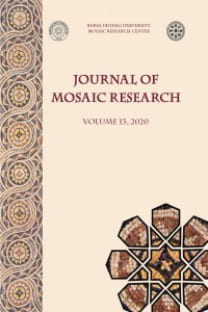Antandros’ta Bulunan Roma Evi Mozaikleri
Antandros, Roma Evi, opus tessellatum, geometrik motifler, MS 4. yüzyıl
The Mosaics of Roman House in Antandros
Roman house, opus tessellatum, geometric motifs, struggle with snake, 4th century AD,
___
- Bairrāo Oleiro 1965 M. Bairrāo Oleiro, “Mosaïques Romaines du Portugal”, CMGR I, 257-265.
- Balty 1977 J. Balty, Mosaïques Antiques de Syrie, Bruxelles.
- Campbell 1991 S. Campbell, The mosaics of Aphrodisias in Caria, nt., Canada, Pontifical Institute of Mediæval Studies.
- Décor I C. Balmelle – M. Blanchard Lemée – J. Christophe – J. P. Darmon – A. M. Guimier Sorbets – H. Lavagne – R. Prudhomme – H. Stern, Le Décor Géométrique De La Mosaïque Romaine I, Picard Editeur, Paris, 1985.
- Décor II C. Balmelle – M. Blanchard Lemée – J. P. Darmon – S. Gozlan – M. P. Raynaud, Le Décor Géométrique De La Mosaïque Romaine II, Picard Editeur, Paris, 2002.
- Jobst 1977 W. Jobst, Römische mosaiken aus Ephesos I. Die hanghäuser des embolus, Wien, Verlag Der Östtreichischen Akademie der Wissenschaften.
- Jobst 2011 W. Jobst, “Das Mosaikpaviment der frühchristlichen Basilika von Gönen/Germe in Mysien (Hellespont)”, 11. Internetional Colloquium on Ancient Mosaic, October 16th - 20th, 2009 Bursa, 483-502.
- LRBC II R.A.G. Carson – J.P.C. Kent, Late Roman Bronze Coinage, Part II, London, 1965.
- Polat vd. 2015 G. Polat – Y. Polat – K. Yağız – S. Üney – R. Aktaş – D. Z. Arkan – A. Üney – A. Cumalıoğlu – E. Açar – E. Kıraç, “Antandros 2013 Yılı Kazıları”, 36. KST 3, 135-158.
- RIC VII P.M. Bruun, The Roman Imperial Coinage, Constantine and Licinius: A.D. 313-337, London, 1966.
- RIC X J. P. C. Kent, The Roman Imperial Coinage, The Divided Empire and The Fall of The Western Parts AD 395-491, London, 1994.
- Tok 1994 E. Tok, Sardes’deki (Sart) Geç Roma Erken Bizans Dönemi Mozaikleri, Lisans Tezi, Ege Üniversitesi, İzmir.
- Tok 2013 E. Tok, “Nymphaion (Kemalpaşa) yakınlarında Bir Roma Villasının Mozaikleri”, JMR 6, 59-105.
- Waywell 1979 S. E Waywell, “Roman mosaics in Greece”, AJA 83-3, 293-321 pl. 45-52.
- ISSN: 1309-047X
- Başlangıç: 2008
- Yayıncı: Ululdağ Üniversitesi, Mozaik Araştırlmaları Merkezi
Penela, Portekiz’de Yer Alan São Simão Roma Villası’ndan Mozaikler
Sónia VICENTE VICENTE, Ana Luísa MENDES
Batı Doğu ile Buluşuyor: Ionia’nın Roma Mozaikleri
Bracara Augusta’nın Roma Mozaikleri: Dekoratif Motiflerin Yeniden Okunması ve Yeniden Yorumlanması
Fátima ABRAÇOS, Licínia WRENCH
Roma: İÖ 2. yüzyıl’da Ekonomik Değişim - Lüks Bir Ürün Olarak Mozaik Konteksti
Augusta Emerita’nın (Merida) Mozaik Üretimi
Algarve’daki (Portekiz) Mozaikler ve Roma Resimleri Üzerindeki Figüratif Unsurlar
Hispanik Meseta Norte’ninMozaikleri: Evreler, Atölyeler, Sanatsal Yönü
Fernando REGUERAS, Caridad SAN JOSÉ
Kırsal Kentler: Lusitania Villaları’nda Dekoratif Programlar ve Mimari Modeller
Batı Roma Lusitania Epigrafik Anıtlar Üzerinde Doğudan Yansımalar
